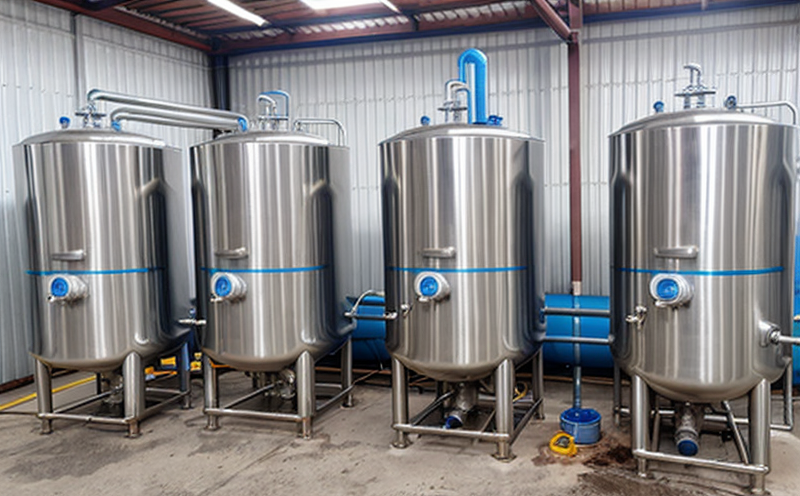ASTM D1426 Ammonia Test in Cooling Water
The ASTM D1426 standard provides a comprehensive methodology for determining ammonia in cooling water, which is critical for maintaining the efficiency and longevity of industrial machinery that relies on this type of water. In sectors such as power generation, manufacturing, and chemical processing, cooling systems are essential to manage heat dissipation effectively. However, the presence of ammonia can lead to scaling, corrosion, and operational inefficiencies if not properly managed.
Ammonia in cooling water can arise from various sources including makeup water, leaks in the system, or biocides used for microbial control. The test outlined by ASTM D1426 is designed to detect even trace amounts of ammonia, ensuring that operators have a clear picture of their water quality. This information is crucial for making informed decisions about maintenance schedules and chemical treatments.
One of the key aspects of this test is its sensitivity. The method allows detection at levels as low as 0.1 mg/L (ppm), which is below the typical threshold for concern in many industrial settings. However, higher concentrations can indicate issues that need immediate attention. By regularly monitoring ammonia levels, operators can prevent potential problems such as increased corrosion rates or scaling deposits on heat exchangers.
The procedure described in ASTM D1426 involves several steps to ensure accurate results. Initially, a sample of the cooling water is collected and preserved with a stabilizing agent to maintain its chemical composition until analysis. The sample then undergoes dilution if necessary before being analyzed using colorimetric methods or other analytical techniques specified by the standard.
The importance of this test cannot be overstated in terms of both operational efficiency and environmental responsibility. Inefficient cooling systems due to ammonia build-up can lead to increased energy consumption, higher maintenance costs, and reduced productivity. On a broader scale, improper management of ammonia in industrial processes contributes to water pollution if it escapes into natural water bodies via drainage.
Moreover, adhering to standards like ASTM D1426 helps organizations meet regulatory requirements set by agencies such as the Environmental Protection Agency (EPA) and Occupational Safety & Health Administration (OSHA). These regulations aim not only at protecting workers' health but also at ensuring that industrial operations do not adversely affect local ecosystems.
For quality managers, compliance officers, R&D engineers, and procurement professionals involved in maintaining or managing industrial cooling systems, understanding the nuances of ASTM D1426 is essential. Regular testing according to this standard allows for proactive management of ammonia levels, thereby extending equipment life, reducing downtime, and minimizing environmental impact.
Real-World Usage Notes: In practice, facilities might perform this test monthly or quarterly depending on the specific requirements dictated by their cooling system design and operational conditions. Results from these tests are typically documented in detailed reports that form part of ongoing maintenance records.
- Why Choose This Test: Detects ammonia at low concentrations (0.1 mg/L), ensuring optimal performance of cooling systems.
- Why Choose This Test: Compliance with industry standards helps avoid penalties and ensures safe operations.
Why Choose This Test
The ASTM D1426 ammonia test in cooling water offers several advantages over alternative testing methods:
- Precision: The method ensures precise detection of even trace amounts of ammonia, crucial for maintaining optimal system performance.
- Compliance: By adhering to this standard, facilities ensure they meet regulatory requirements and industry best practices.
- Economic Benefits: Early identification and addressing of ammonia issues can prevent costly repairs and replacements.
The test's precision and reliability make it an indispensable tool for maintaining efficient and sustainable cooling systems. It allows operators to make informed decisions about their operations, ultimately leading to cost savings and reduced environmental impact.
Environmental and Sustainability Contributions
The ASTM D1426 ammonia test plays a vital role in promoting sustainability by helping industries manage their water resources more effectively. By detecting and controlling ammonia levels, facilities can reduce the risk of harmful discharges into local water bodies.
Efficient cooling systems contribute to reduced energy consumption and lower carbon emissions, which are key factors in combating climate change. Monitoring ammonia through ASTM D1426 supports these efforts by ensuring that industrial processes operate at peak efficiency without unnecessary waste or pollution.
In addition to direct environmental benefits, adhering to this test contributes positively to corporate social responsibility goals. It demonstrates a commitment to responsible resource management and safe working practices within the facility.
Competitive Advantage and Market Impact
Regularly performing ASTM D1426 tests can provide significant competitive advantages for businesses operating in water-intensive industries:
- Improved Operational Efficiency: By keeping ammonia levels in check, facilities ensure that their cooling systems run smoothly and efficiently.
- Risk Mitigation: Early detection of potential issues prevents costly disruptions to production schedules.
- Innovation Opportunities: Insights gained from consistent monitoring can inspire new approaches to water management and process optimization.
These advantages translate into enhanced reputation among customers, stakeholders, and regulatory bodies. A commitment to sustainable practices like those supported by ASTM D1426 is increasingly becoming a differentiator in the market place.





